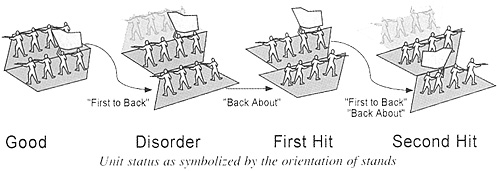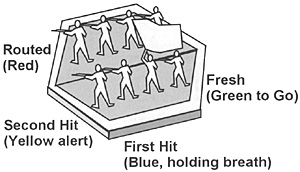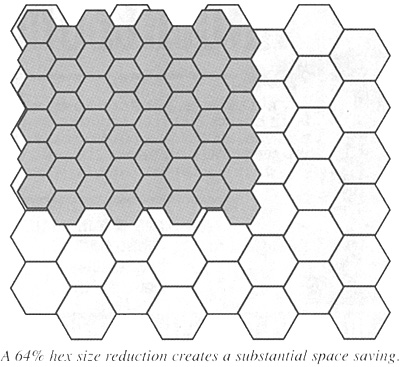 HEXAGON-SHAPED STANDS
HEXAGON-SHAPED STANDS
Hex Command II is re-written to include a new option: 2 stands per unit infantry, cavalry or artillery. Each stand is one-half of a hexagon made from matte board.
Whereas the former version enabled any number of stands as long as they fit in a 4 inch hexagon and our existing collection has ? inch thick Neoprene rubber stands 1 x I inch, the HCII uses a 2 ? inch hexagon grid. When you put the two stands of a unit together to form a hexagon, the unit is in good order. By changing the orientation of the stands, you visually signify a change to unit status: disorder, first hit, second hit and on the third hit, remove a stand and rout the unit. This means no more markers on the table.
"PLATEROSTER"
Mounting the entire unit on a single hexagon stand enables at least 6 status indicators if you paint different or "status" colors on the various sides of a ? inch thick Balsa-wood movement plate. If all units are mounted onto these movement plates, they serve like the Click stands that are so popular right now; they are the mechanical roster underneath each unit. Simply turn the color to the back of the unit to show it's current status. Disorder (for now at least), will still have to be shown by re-arranging the stands.
 PlateRoster: Coloring the sides of a movement plate to show unit status.
PlateRoster: Coloring the sides of a movement plate to show unit status.
This also serves a purpose for internet broadcasting of the miniatures games. And speaking of that, another thing we found was that the stand color needed to be different for each arm, such that it could be easily recognized on the computer monitor. Therefore, infantry are light green as before, cavalry are some other color and artillery stands will match the color of the table e.g. tan colored shipping paper is our table top where we've got the hex pattern traced onto.
10x6 TABLE IN A 6x4 FOOTPRINT
How did all this come about? GameFest Milwaukee.
Prior to attending the convention we already began to wonder if non-historical players would be willing to move around a 16 foot table. They were, but at a cost both to themselves and to us: we began to get quite tired from running so many games, in so many eras, on such a large gaming surface.
 On the drive back to Chicago, we came to the conclusion that Jeff's first thought, he mention about 5 years ago about using a smaller hexagon grid, was probably going to be the best after all.
On the drive back to Chicago, we came to the conclusion that Jeff's first thought, he mention about 5 years ago about using a smaller hexagon grid, was probably going to be the best after all.
Therefore, we've come back to the conclusion that 15mm or smaller IS the answer, and therefore all our 1/72 1/76 and 20mm collections are up for sale or trade. We're too old and too tired for big tables. We need to sit across from each other and move or troops around and see the whole field easier. We need to do Gettysburg on a 6x4 table and the 2 ? inch hexagon does it, while still retaining most or all of our 15mm terrain and not going to the pea-sized stuff of Microarmor. Also, it makes internet broadcasting MUCH easier.
The demographics speak for themselves: You just can't play a good enough game with LOTS of stuff on a small table in 1/72, though it looks way cooler than 15mm.
The fact is, everything is now available except 30 Years War in 15mm, and we are hoping someone does that soon.
Terry Cabak is owner/operator of Imagine Image Multimedia, marketing Game Mapper software on "The Wargames CD," colored four inch hexagon grid paper and "Paper General" miniatures from Mark Sergeyev at www.imagineimage.og
Back to MWAN # 131 Table of Contents
Back to MWAN List of Issues
Back to MagWeb Magazine List
© Copyright 2004 Legio X
This article appears in MagWeb.com (Magazine Web) on the Internet World Wide Web.
Other articles from military history and related magazines are available at http://www.magweb.com